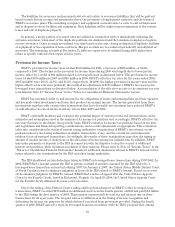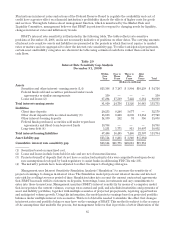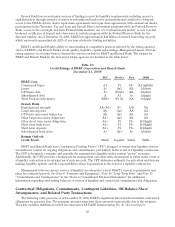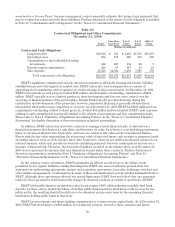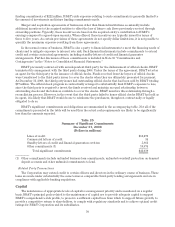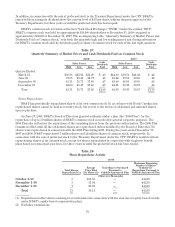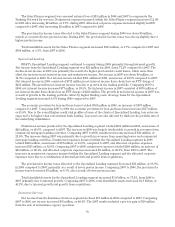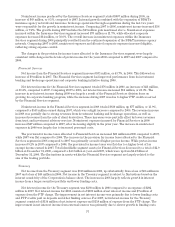BB&T 2008 Annual Report Download - page 67
Download and view the complete annual report
Please find page 67 of the 2008 BB&T annual report below. You can navigate through the pages in the report by either clicking on the pages listed below, or by using the keyword search tool below to find specific information within the annual report.
The following table shows the effect that the indicated changes in interest rates would have on EVE as
projected under the “most likely” interest rate scenario incorporated into the EVE model. Key assumptions in
the preparation of the table include prepayment speeds of mortgage-related assets, cash flows and maturities of
derivative financial instruments, loan volumes and pricing, and deposit sensitivity. The resulting change in the
economic value of equity reflects the level of sensitivity that EVE has in relation to changing interest rates.
Table 22
Economic Value of Equity (“EVE”) Simulation Analysis
Hypothetical Percentage
Change in EVE
EVE/Assets
Change in
Rates
December 31, December 31,
2008 2007 2008 2007
2.00% 7.2% 6.1% (2.6)% (9.6)%
1.00 7.4 6.5 1.0 (3.9)
No Change 7.4 6.7 — —
(0.25) 7.3 NA (1.3) NA
(1.00) NA 6.5 NA (2.8)
(2.00) NA 5.8 NA (13.8)
Liquidity
Liquidity represents BB&T’s continuing ability to meet funding needs, primarily deposit withdrawals, timely
repayment of borrowings and other liabilities, and funding of loan commitments. In addition to the level of liquid
assets, such as trading securities and securities available for sale, many other factors affect the ability to meet
liquidity needs, including access to a variety of funding sources, maintaining borrowing capacity in national money
markets, growing core deposits, the repayment of loans and the capability to securitize or package loans for sale.
The purpose of BB&T Corporation (the “Parent Company”) is to serve as the capital financing vehicle for the
operating subsidiaries. The assets of the Parent Company consist primarily of cash on deposit with Branch Bank,
equity investments in subsidiaries, advances to subsidiaries, accounts receivable from subsidiaries, and other
miscellaneous assets. The principal obligations of the Parent Company are principal and interest on master notes,
long-term debt, and redeemable capital securities. The main sources of funds for the Parent Company are
dividends and management fees from subsidiaries, repayments of advances to subsidiaries, and proceeds from
issuance of long-term debt and master notes. The primary uses of funds by the Parent Company are for the
retirement of common stock, investments in subsidiaries, advances to subsidiaries, dividend payments to
shareholders, and interest and principal payments due on long-term debt and master notes.
The primary source of funds used for Parent Company cash requirements has been dividends declared from
Branch Bank, which totaled $1.2 billion during 2008, and net proceeds from the issuance of long-term debt, which
totaled $716 million in 2008. Funds raised through master note agreements with commercial clients are placed in
a note receivable at Branch Bank primarily for its use in meeting short-term funding needs and, to a lesser
extent, to support the short-term temporary cash needs of the Parent Company. At December 31, 2008 and 2007,
master note balances totaled $1.7 billion and $1.8 billion, respectively.
In late 2005, the SEC passed major changes to the securities registration process, which especially benefited
larger companies who frequently access the capital markets. The changes to the securities registration process
allow companies who have met certain eligibility requirements to file a registration statement that immediately
becomes effective and permits the company to pay the fees related to the registration of the securities at the time
of issuance. This has effectively eliminated the need to periodically file shelf registration statements and estimate
the amount of securities that will be needed in the future. The change in regulations also has greatly enhanced the
ability of BB&T to access the capital markets.
The Parent Company had five issues of subordinated notes outstanding totaling $3.1 billion at December 31,
2008. In addition, as of December 31, 2008, BB&T had $2.3 billion of junior subordinated debentures outstanding
to unconsolidated trusts. Please refer to Note 10 “Long-Term Debt” in the “Notes to Consolidated Financial
Statements” for additional information with respect to these subordinated notes and junior subordinated
debentures.
67








